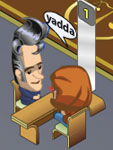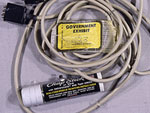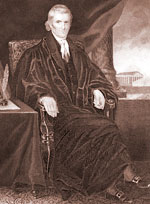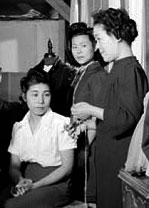Picking Civics Textbooks

We are a new charter school in New Mexico. I have been tasked with ordering government textbooks. Do you have recommendations?
My first suggestion is that you look for outstanding curriculum, not just outstanding textbooks. I have seen most government textbooks gather dust on classroom shelves, while there is a host of interactive government curriculum that engages students in problem solving, group work, research, and exploration of major themes.
One approach to curriculum adoption is to use the leading experiential programs to create your own curriculum, rather than use a textbook as its centerpiece. This is what I have done over 10 years teaching high school government, while my class set of Magruder's American Government textbooks stays mostly on the shelf. The programs I recommend below all actively involve students in collaborative learning, research, public speaking, deliberation, and other skills that good citizens must have. These programs have strong content but also require a level of activity that is absent in the traditional textbook approach to civic education. Most state civics standards are weighted heavily toward learning about the history and principles of the U.S. Constitution and the operation of our federal government. Most state standards also include learning about state and local government, citizen participation in government, foreign policy, and the government's role in the economy. I recommend the following project-based experiential curriculum to address each of those standards individually.
The best curriculum for teaching the history and principles of the U.S. Constitution is We the People...the Citizen and the Constitution, published by the Center for Civic Education. Available at elementary, middle, and high school reading levels, this textbook presents the Constitution through its historical context and philosophical foundations rather than as a series of facts to be memorized. The culminating activity associated with the We the People curriculum is a simulated Congressional hearing, in which students grapple with big questions about our form of government and defend their answers before a panel of experts. See students answering questions at the national finals here. While Congressional funding for this and other civic education programs was recently eliminated, the curriculum is still available for purchase, and many states will continue to hold hearings and offer professional development. Contact your state coordinator to inquire about the We the People program in your area.
The CHOICES program at Brown University produces an outstanding and engaging unit for evaluating U.S. foreign policy alternatives. The U.S. Role in a Changing World consists of background readings, optional learning activities, and a culminating activity in which students simulate a U.S. Senate Committee Hearing and deliberate four alternative "futures" for the United States' role in the world. Also check out the other fine resources produced by CHOICES.
The Center for Civic Education also publishes the We the People...Project Citizen curriculum. Project Citizen is the leading program for getting students directly involved in state and local government. Far from a textbook, Project Citizen is a brief manual that students and teachers use to analyze public policy problems and propose realistic policy solutions. The culminating activity is a showcase in which students present their portfolios to a panel of experts and policymakers. Here is a video overview of Project Citizen.
Finally, I recommend supplementing your government curriculum with online resources. The following websites provide free interactive activities to enhance your teaching. Street Law hosts the Landmark Supreme Court Cases site, which provides resources for teaching about the most important cases through moot courts and other interactive strategies. Budget Hero is a fun way for students to understand the federal budget. The Center on Congress hosts interactive learning modules on the role of Congress. C-SPAN classroom provides "Timely Teachable Videos," "Constitution Clips," and lesson plans based on C-SPAN's deep well of video archives. IDEAlog presents an interactive approach to understanding political ideologies.
Among traditional high school government textbooks, Magruder's American Government is a good bet. This high school textbook presents a comprehensive explanation of every major topic that is addressed in a government class, including the Constitution, foreign policy, economics, local government, and comparative government. To help teachers differentiate instruction and provide accessible content to English language learners and students with special needs, Magruder’s now offers a "Foundation Series" textbook. This book is designed for students reading at the 6th-grade level, yet it is aligned with the traditional high school reading level textbook. Magruder's also offers the "Experience It!" hands-on curriculum "for teachers looking for an experiential approach to American Government that focuses on simulations and online learning." Magruder's textbooks are not cheap, at about $85 per student edition, but if you want a traditional comprehensive government textbook as the core of your curriculum and have the budget to support it, it's a good place to start. Government Alive!, published by the Teachers' Curriculum Institute, provides a more interactive yet comprehensive approach to government. You can get a free trial and sample chapters on request. When reviewing textbooks I ask myself the following questions: Is it engaging for students to read? Does it address all the standards for my course? Is the reading differentiated for students below grade level? Does it fit in my budget?

 In DIHR? the player manages a legal firm specializing in constitutional law. The player first selects whether to do the "Full Edition" of rights throughout the Constitution or "Bill of Rights" which focuses on rights within the first 10 Amendments. He or she then customizes their lawyer and chooses a partner lawyer who specializes on a right. The game takes place over seven rounds, each representing a day. In each round the player tries to earn as many prestige points as possible for the firm by taking on clients and winning their cases. This involves a three-step cycle.
In DIHR? the player manages a legal firm specializing in constitutional law. The player first selects whether to do the "Full Edition" of rights throughout the Constitution or "Bill of Rights" which focuses on rights within the first 10 Amendments. He or she then customizes their lawyer and chooses a partner lawyer who specializes on a right. The game takes place over seven rounds, each representing a day. In each round the player tries to earn as many prestige points as possible for the firm by taking on clients and winning their cases. This involves a three-step cycle. George Sayit, for example, begins with freedom of expression. The player can, through successful gameplay, unlock George's ability to plead cases on the freedom of religion, right to vote regardless of race, and, finally, right to vote regardless of gender. The player can ultimately hire six lawyers, each of whom can have four areas of expertise. As a result increasing numbers of different constitutional scenarios can be brought up in each successive round of gameplay.
George Sayit, for example, begins with freedom of expression. The player can, through successful gameplay, unlock George's ability to plead cases on the freedom of religion, right to vote regardless of race, and, finally, right to vote regardless of gender. The player can ultimately hire six lawyers, each of whom can have four areas of expertise. As a result increasing numbers of different constitutional scenarios can be brought up in each successive round of gameplay. At the end of each round, the player gets a summary of his or her performance. This takes the form of a newspaper that includes descriptions of the cases and relevant constitutional issues from the round. After the summary, the player can spend any earned prestige points to improve the firm—an important motivator since success at matching clients and lawyers leads to tangible gameplay bonuses. New lawyers can be hired, allowing the player to handle a greater variety of cases and win more prestige. In addition, each lawyer's desk can be enhanced with bonus items. These increase that lawyer's speed in handling cases, likelihood of learning a new area of constitutional law, or the prestige gained for a successful case. Finally, improvements can be made to the waiting area to increase the number of clients it can hold and the amount of time they will wait before storming off in rage—a feature that becomes especially important in later rounds as the number of clients increases.
At the end of each round, the player gets a summary of his or her performance. This takes the form of a newspaper that includes descriptions of the cases and relevant constitutional issues from the round. After the summary, the player can spend any earned prestige points to improve the firm—an important motivator since success at matching clients and lawyers leads to tangible gameplay bonuses. New lawyers can be hired, allowing the player to handle a greater variety of cases and win more prestige. In addition, each lawyer's desk can be enhanced with bonus items. These increase that lawyer's speed in handling cases, likelihood of learning a new area of constitutional law, or the prestige gained for a successful case. Finally, improvements can be made to the waiting area to increase the number of clients it can hold and the amount of time they will wait before storming off in rage—a feature that becomes especially important in later rounds as the number of clients increases. The ease of the control system and the core gameplay are important features of the game, adding to its suitability as a classroom tool. At the start of the game, onscreen hints helpfully label important areas of the firm and the screen—these hints can be left on or turned off at the player's discretion. All decisions are made through clicking on the relevant button or area in the game with the mouse. For those who still would like more guidance, there is even a teacher's guide that provides a detailed description of the game written for those less familiar with game motifs.
The ease of the control system and the core gameplay are important features of the game, adding to its suitability as a classroom tool. At the start of the game, onscreen hints helpfully label important areas of the firm and the screen—these hints can be left on or turned off at the player's discretion. All decisions are made through clicking on the relevant button or area in the game with the mouse. For those who still would like more guidance, there is even a teacher's guide that provides a detailed description of the game written for those less familiar with game motifs.





